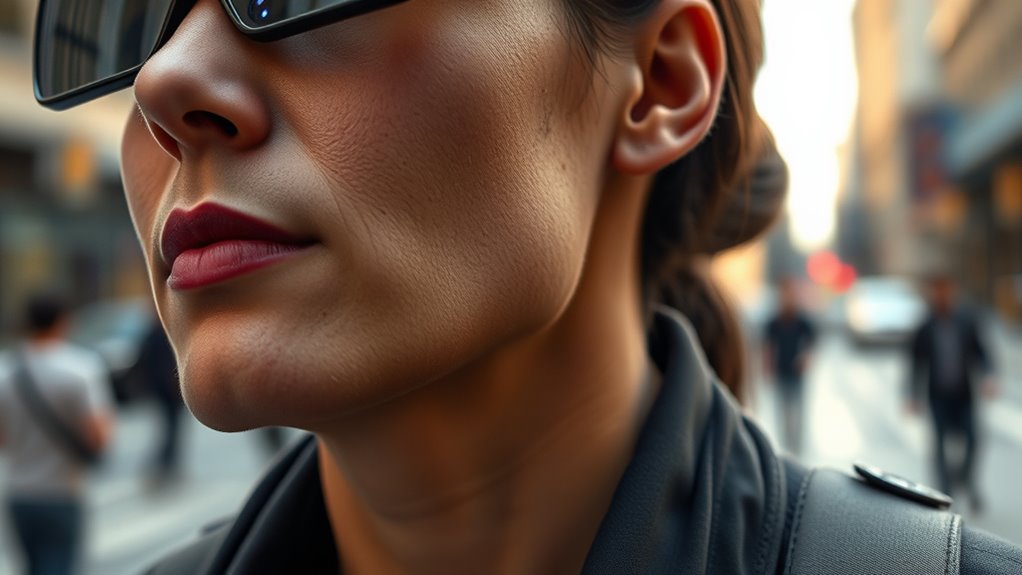Wearable AI devices with 3D vision help you navigate safely and confidently. They actively scan your environment, creating real-time maps of obstacles and pathways. The device then delivers intuitive feedback through audio, haptic, or combined cues, making complex spatial information easy to understand. With customizable settings and simple controls, these tools are designed to boost your independence. Keep exploring to discover how this innovative technology can transform your mobility and daily life.
Key Takeaways
- Wearable AI devices with 3D vision enable real-time environmental mapping to assist blind users in navigation.
- They provide intuitive feedback through audio and haptic cues for obstacle detection and directional guidance.
- Customizable settings ensure the device adapts to individual preferences and different environments.
- Advanced AI algorithms process spatial data to enhance safety and independence indoors and outdoors.
- These innovations are transforming assistive technology, making navigation safer, easier, and more natural for visually impaired users.

Have you ever wondered how wearable AI devices are transforming the way you monitor your health, stay connected, and boost productivity? These innovative tools are not just about tracking steps or heart rate anymore—they’re becoming powerful assistive technology that enhances everyday life, especially for those with visual impairments. With advancements like 3D vision, these wearables now offer a new level of independence, helping blind users navigate their environment safely and confidently. The key to their effectiveness lies in thoughtful user interface design, which guarantees that complex data is accessible and easy to interpret through intuitive feedback methods.
When you wear a device equipped with 3D vision capabilities, it actively scans your surroundings, constructing a real-time spatial map. This data is processed using AI algorithms that identify objects, obstacles, and pathways, then convey this information to you through haptic feedback, audio cues, or both. The user interface design is essential here—it needs to communicate complex spatial information in a way that’s easy to understand without overwhelming you. Developers focus on creating interfaces that prioritize simplicity, using clear signals and minimalistic controls, so you can quickly grasp your environment without distraction or confusion. Through tactile or auditory signals, the device guides you around obstacles, indicating whether you should turn left, right, or proceed forward, effectively becoming your digital sight.
Moreover, these wearable AI devices are designed with accessibility at their core. They often incorporate customizable options, allowing you to adjust feedback intensity or switch between different modes based on your needs. This flexibility is part of effective assistive technology, guaranteeing that the interface adapts seamlessly to your preferences. The goal is to make navigation intuitive, reducing the cognitive load and allowing you to focus on your surroundings rather than the device itself. The user interface design also extends to ease of use—simple, responsive controls mean you won’t need extensive training to get started, and you can rely on the device in various environments, whether indoors or outdoors.
In addition, the integration of 3D vision technology enhances spatial awareness, making the device’s environmental understanding more accurate and reliable. In essence, wearable AI with 3D vision is revolutionizing assistive technology by blending cutting-edge AI with user-centered interface design. It’s not just about providing information; it’s about empowering you to move confidently and independently. By focusing on clear, accessible communication and adaptable controls, these devices are breaking down barriers and opening up new possibilities for blind users, making navigation safer, easier, and more natural than ever before.
Frequently Asked Questions
How Does the AI Adapt to Different User Environments?
You benefit from adaptive learning and environmental sensing, as the AI continually analyzes your surroundings and adjusts its guidance accordingly. It learns your preferences and adapts to different environments, whether crowded streets or quiet alleys. The system uses sensors to detect obstacles and changes in terrain, ensuring safe navigation. This real-time adaptation helps you move confidently, making the experience personalized and responsive to your immediate environment.
What Is the Battery Life of the Wearable Device?
You’ll notice the device’s battery life lasts about 8 hours on a full charge, enough to power your daily adventures. Its battery capacity is optimized with smart power management, conserving energy during quieter moments and boosting it when needed. Imagine the device seamlessly fitting into your day, reliably guiding you without worry — a steady companion that keeps pace with your journey, from morning to evening.
Can the Device Recognize Specific Landmarks or Objects?
Yes, the device can recognize specific landmarks and objects through advanced landmark detection and object recognition features. As you walk, it actively identifies familiar places or obstacles, providing real-time audio feedback to help you navigate confidently. This technology enhances your awareness of the environment around you, making it easier to find your way. You’ll appreciate how seamlessly it integrates landmark detection and object recognition into your daily navigation.
Is the Wearable Compatible With Other Assistive Technologies?
Yes, your wearable is compatible with other assistive technologies, allowing seamless assistive technology integration. You can easily customize the device to suit your specific needs, enhancing your navigation experience. By connecting with hearing aids, Braille displays, or other tools, you guarantee a more thorough support system. This flexibility makes it easier for you to adapt the wearable to your daily routines, improving independence and confidence.
How Secure Is the Data Collected by the Device?
Think of your data as precious cargo, safely guarded by strong locks. The device uses data encryption to keep your information secure, preventing unauthorized access. Plus, it follows strict privacy policies that define how your data is handled and shared. Rest assured, your personal information stays protected, giving you peace of mind while you navigate the world confidently with your wearable AI guide.
Conclusion
With the wearable AI guide’s 3D vision, you’ll confidently conquer crowded corridors and complex crossings. It’s your personal, perceptive partner, providing precise paths and protecting you from pitfalls. As you navigate new neighborhoods, the device delivers detailed directions, dispelling doubt and darkness. Feel the freedom flourish as familiarity follows your footsteps. With this futuristic friend, fear fades, and the journey begins — bold, bright, and beautifully boundless.








